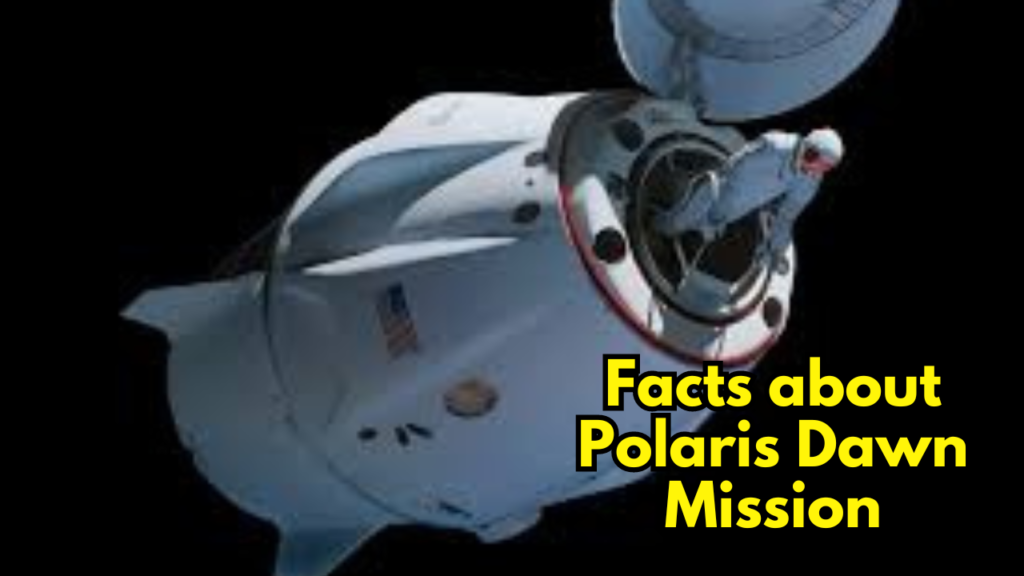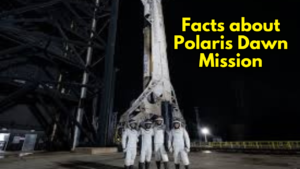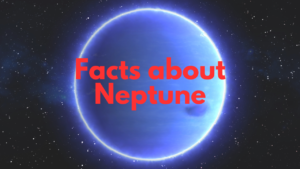
Imagine a project combining adventure with science across the limits of space travel. Polaris Dawn is one mission set to record events with the first private spacewalk and the furthest trip from Earth since the Apollo missions. Today we are going to tell you 15 amazing Facts about Polaris Dawn Mission, so sit in your seats.
Under billionaire Jared Isaacman, the objective is not only about far-off exploration but also about vital scientific research that might support next space missions.
The team will compile crucial data for NASA and test newly developed medical equipment. Polaris Dawn represents a major progress in space exploration.
Motivated to expand knowledge? Let us look at this together.
Here are 15 fascinating facts about Polaris Dawn Mission:
Facts about Polaris Dawn Mission No1. First Commercial Spacewalk: Polaris Dawn aims to conduct the first-ever commercial spacewalk.
The Polaris Dawn mission will be remembered once the first-ever spacewalk by a private company takes place. Astronauts will step out of SpaceX’s Dragon capsule into space in this historic event, only government agencies like NASA or Roscosmos have done before.
Testing new technologies and spacesuits, this spacewalk will equip for next private space missions. Imagine how exciting and carefully planned this mission must be to keep everyone safe and successful!
Not only does SpaceX but the whole private space industry depends on this spacewalk. It shows how private companies can now investigate space outside of governments, so going beyond simple space missions.
Should this effort be successful, private spacewalk, commercial space stations, and maybe lunar or Martian missions would follow.
People are quite eager about this event since it represents a major step towards allowing more people in the future to travel to space.
Facts about Polaris Dawn Mission No2. Highest Orbit in 50 Years:
Since the Apollo era, the highest any crewed mission has gone—the Polaris Dawn mission soared 870 miles above Earth. The crew can carry important experiments not possible closer to Earth thanks to this great height. They also enjoy quite amazing views of the planet.
This aim is about stretching new limits rather than only shattering records. Traveling this far, Polaris Dawn is testing space technology and compiling data to support next space missions including those to the Moon or Mars. Long space missions rely on our understanding of human and technological behavior in surroundings with more radiation. This project will supply such data.
Facts about Polaris Dawn Mission No3. Four-Person Crew: The crew consists of Jared Isaacman, Scott “Kidd” Poteet, Sarah Gillis, and Anna Menon.
Four qualified individuals make up the Polaris Dawn team. Leading the Inspired 4 mission is seasoned pilot and businessman Jared Isaacman. Along with him are retired Air Force officer Scott “Kidd” Poteet; SpaceX space operations engineer Sarah Gillis; and medical officer Anna Menon. Every person possesses unique abilities that fit for this crucial task.
The crew demonstrates how critical different skills and teamwork are for space missions. Their combined expertise enables them to overcome space’s obstacles, including performing spacewalks and scientific activities. Strong ties and love of space among the team inspire others and provide a model for next space enthusiasts and astronauts.
Facts about Polaris Dawn Mission No4. Jared Isaacman: The mission is funded and commanded by billionaire entrepreneur Jared Isaacman.
Polaris Dawn mission sponsor Jared Isaacman is quite familiar with space. Founder and CEO of Shift4 Payments, he has made financial contributions to let space exploration bloom. Before this, he oversaw the Inspiration4 project, the first space flight headed by just civilians funding St. Jude Children’s Research Hospital. Thanks in great part to his visionary leadership, Polaris Dawn shows how far private space missions can reach.
Isaacman’s respect of space goes beyond simple personal desire. He wants to inspire others by showing them how realistic private space flight could be. Funding and supervising these projects enables him to show that everyone with the right vision and tools uses space, not only for government entities. His work is enabling new explorers and enabling everyone to discover more easily space travel.
Facts about Polaris Dawn Mission No5. SpaceX Dragon Capsule: The crew is traveling aboard SpaceX’s Dragon capsule.
Riding in SpaceX’s Dragon capsule, a spacecraft known for dependability and cutting-edge technologies, Polaris Dawn’s team is Among the several missions the Dragon has been used for is astronaut transportation to and from the International Space Station. Its architecture combines modern life support systems, touchscreen controls, and automatic connection with other spacecraft. This mission will especially test the Dragon’s capabilities especially during a scheduled spacewalk.
Combining comfort, utility, and safety, the Dragon capsule marks a significant progress in spacecraft design. Its consistency on several missions has shown that it is human spaceflight reliable. The Polaris Dawn mission will challenge the Dragon even more as helping to compile vital information to forward next spacecraft advances This initiative shows SpaceX’s will to forward space travel technologies.
Facts about Polaris Dawn Mission No6. Falcon 9 Rocket: The mission was launched using a SpaceX Falcon 9 rocket.
Launched using SpaceX’s Falcon 9 rocket, a primary player in commercial space flight, the Polaris Dawn project was Because its first stage can land back on Earth for usage once more, the Falcon 9 is known for being reusable. This greatly reduces the cost of space missions, allowing more reasonably priced space travel. Among the several missions the Falcon 9 has proven capable of are astronaut transportation, cargo delivery to the ISS, and satellite launching.
Polaris Dawn shows SpaceX’s commitment to reducing space travel expenses and environmental impact using the Falcon 9. The ability to reuse the rocket marks a major change allowing more frequent and reasonably priced missions. The effective launch of Polaris Dawn emphasizes the dependability and flexibility of the Falcon 9, so enhancing its great legacy. This aim underlines how important modern technologies are in allowing more people to access space exploration by streamlining its process.
Facts about Polaris Dawn Mission No7. Science Experiments: The mission is carrying 36 different experiments from 31 institutions.
The Polaris Dawn project is running thirty-six experiments across thirty-different companies. These tests center on compiling information on space travel, including human check, radiation exposure, and material behavior in space. The high altitude of the mission provides special testing environments absent from closer proximity to Earth. The findings will equip us to better grasp space and get ready for next long-distance space missions.
The range of studies indicates the significance of this goal for science. Working with several companies helps to foster innovation in space research by stressing teamwork. Not only will the gathered data help the individuals engaged but also the larger scientific community. This endeavor demonstrates how commercial space missions might advance our knowledge of space and augment our scientific understanding.
Facts about Polaris Dawn Mission No8. NASA Collaboration: Some experiments are designed to gather data for NASA’s Human Research Program.
Certain of the studies are especially meant to support NASA’s Human Research Program. This emphasizes the need of cooperation for space exploration among government organizations and private businesses. Long trips to the Moon, Mars, and beyond depend on NASA’s ability to comprehend how space affects the human body, thus the collected data will be crucial. This project is a prime illustration of how commercial space missions might support and improve government-owned space projects.
SpaceX’s cooperation with NASA on this mission demonstrates how the public and commercial sectors might cooperate in space exploration. Their strengths taken together will help them to accomplish common objectives. Future partnerships based on this cooperation demonstrate how commercial missions might support government space projects. Should this mission be successful, more combined missions will be possible, so accelerating the advancement of space exploration.
Facts about Polaris Dawn Mission No11. Delayed Launch: The mission faced more than two weeks of delays before finally launching.
Before ever launching, Polaris Dawn experienced delays totaling more than two weeks. Bad storms and technical issues caused these delays. Notwithstanding these obstacles, the mission started effectively, demonstrating SpaceX team’s will. The delays gave more time for preparation, so guaranteeing the success and safety of the mission.
The delays expose the intricacy of space missions. Sending a spacecraft calls for much preparation, and even minor problems can cause major delays. These difficulties, meanwhile, also support learning and development. Despite the delays, Polaris Dawn’s successful launch attests to the SpaceX team’s commitment and ability. It emphasizes in space exploration the need of patience and adaptability.
Facts about Polaris Dawn Mission No12. Five-Day Mission: The mission is planned to last approximately five days.
The Polaris Dawn expedition will run for five days or so. The crew will conduct historical spacewalk and scientific experiments during this period. Though brief, the mission is full of activities with every moment meticulously scheduled. The five days let the crew become used to space and finish their assignments successfully.
Polaris Dawn is a significant phase of space exploration even if it is brief. The hectic schedule reveals how much, with careful planning, one can accomplish in a limited period. The accomplishment of the mission will provide vital data for next longer missions. It also demonstrates how significantly scientific research and exploration can benefit from private space missions.
Facts about Polaris Dawn Mission No13. SpaceX Technology Testing: The crew will test SpaceX technology that could be pivotal for future deep space exploration.
Different SpaceX technologies that might be crucial for next space missions will be tested by the Polaris Dawn team. These comprise systems enabling astronauts to survive, communicate, and navigate in space. Testing them in space allows SpaceX to obtain valuable data to advance the instruments for next trips. For more difficult missions to locations like the Moon and Mars, this is crucial to ensure the machinery runs effectively.
Testing these technologies reveals SpaceX’s constant innovative and improving attitude. Every test provides valuable comments for engineers so they may adjust. Strong systems able to manage deep space challenges depend on this process. Success on these tests will enable us to get closer to having people live in space and help ready us for more ambitious missions.
also see: 15 Facts about NASA Lunar Navigation Challenge
Facts about Polaris Dawn Mission No14. Women in Space: Sarah Gillis and Anna Menon have traveled farther from Earth than any other women ever have.
Part of the Polaris Dawn team, Sarah Gillis and Anna Menon have ventured farther from Earth than any other women. Showing that women are increasingly involved in space exploration, this is a significant event in space history. Young girls and women hoping for professions in science and technology will find inspiration in their success.
Including Anna Menon and Sarah Gillis on the mission also emphasizes the value of diversity in space exploration. It shows that regardless of gender, everyone uses space. Emphasizing women’s achievements helps more women enter the sciences and technologies, which is absolutely vital for advancement in space.

Facts about Polaris Dawn Mission No15. Private Space Exploration: Polaris Dawn is a significant step in the commercialization of space exploration, showcasing the potential for private missions to conduct scientific research and exploration.
An important first step in private space exploration, Polaris Dawn demonstrates how scientifically minded private missions may probe space. Private people and businesses lead and finance it, so demonstrating that space is no more only for government agencies. Polaris Dawn’s success might motivate more small businesses to fund space exploration, thus generating more fresh ideas and possibilities.
By including fresh ideas and tools, private missions like Polaris Dawn are altering space travel. They enhance what governments are doing and create more opportunities for scientific study as well as even space tourism. The accomplishment of this project could inspire more private space projects and help us to approach a time when everyone can access space.





